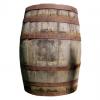Recently I've continued working on my own framework and tried implementing some diffuse lighting shader.
First I've create a shader that only takes a POSITION semantic after that I created a shader that takes a POSITION & TEXCOORD semantic
But now when I'm using POSITION TEXCOORD NORMAL my cube turns into something like this.
I looked at the VertexStruct and the Inputlayout and there does not seem to be anything wrong with it.
//VERTEX STRUCT
//-------------------------------------------------------------------------------------
struct VertexPosTexNorm : public VertexPos
{
public:
VertexPosTexNorm()
:VertexPos()
, TexCoord(0,0)
, Normal(-1,-1,-1)
{
}
VertexPosTexNorm(const XMFLOAT3& p, const XMFLOAT3& n, const XMFLOAT2& uv)
: VertexPos(p)
, TexCoord(uv)
, Normal(n)
{
}
VertexPosTexNorm(float px, float py, float pz, float u, float v, float nx, float ny, float nz)
: VertexPos(px, py, pz)
, TexCoord(u,v)
, Normal(nx,ny,nz)
{
}
VertexPosTexNorm(const VertexPosTexNorm& v)
: VertexPos(v.Position.x, v.Position.y, v.Position.z)
, TexCoord(v.TexCoord.x, v.TexCoord.y)
, Normal(v.Normal.x,v.Normal.y,v.Normal.z)
{
}
VertexPosTexNorm(const VertexPos& v)
:VertexPos(v.Position.x,v.Position.y,v.Position.z)
, TexCoord(-1,-1)
, Normal(-1, -1, -1)
{}
VertexPosTexNorm(const VertexPosTex& v)
:VertexPos(v)
, TexCoord(v.TexCoord)
, Normal(-1,-1,-1)
{}
bool operator==(const VertexPosTexNorm& rhs) const
{
return XMFloat3Compare(this->Position, rhs.Position) && XMFloat3Compare(this->Normal,rhs.Normal) && XMFloat2Compare(this->TexCoord,rhs.TexCoord);
}
XMFLOAT2 TexCoord;
XMFLOAT3 Normal;
};
//VERTEX BUFFERS
//-------------------------------------------------------------------------------------
HRESULT hr = S_OK;
D3D11_BUFFER_DESC bdVertex;
ZeroMemory(&bdVertex, sizeof(bdVertex));
// Create vertex buffer
bdVertex.Usage = D3D11_USAGE_DEFAULT;
bdVertex.ByteWidth = sizeof(VertexPosTexNorm)* (int)_vertexVec.size();
bdVertex.BindFlags = D3D11_BIND_VERTEX_BUFFER;
bdVertex.CPUAccessFlags = 0;
bdVertex.MiscFlags = 0;
bdVertex.StructureByteStride = 0;
D3D11_SUBRESOURCE_DATA initDataVertex;
ZeroMemory(&initDataVertex, sizeof(initDataVertex));
initDataVertex.pSysMem = _vertexVec.data();
hr = GRAPHICSDEVICEMANAGER->GetGraphicsDevice3D()->GetDevice()->CreateBuffer(&bdVertex, &initDataVertex, &package.vertexBuffer);
if (FAILED(hr))
return hr;
D3D11_BUFFER_DESC bdIndex;
ZeroMemory(&bdIndex, sizeof(bdIndex));
bdIndex.Usage = D3D11_USAGE_DEFAULT;
bdIndex.ByteWidth = sizeof(DWORD)* (int)_indexVec.size();
bdIndex.BindFlags = D3D11_BIND_INDEX_BUFFER;
bdIndex.CPUAccessFlags = 0;
bdIndex.MiscFlags = 0;
bdIndex.StructureByteStride = 0;
D3D11_SUBRESOURCE_DATA initDataIndex;
ZeroMemory(&initDataIndex, sizeof(initDataIndex));
initDataIndex.pSysMem = _indexVec.data();
hr = GRAPHICSDEVICEMANAGER->GetGraphicsDevice3D()->GetDevice()->CreateBuffer(&bdIndex, &initDataIndex, &package.indexBuffer);
if (FAILED(hr))
return hr;
return hr;
//INPUT LAYOUT
//-------------------------------------------------------------------------------------
D3D11_INPUT_ELEMENT_DESC polygonLayout[3];
unsigned int numElements;
// Create the vertex input layout description.
// This setup needs to match the VertexType stucture in the ModelClass and in the shader.
polygonLayout[0].SemanticName = "POSITION";
polygonLayout[0].SemanticIndex = 0;
polygonLayout[0].Format = DXGI_FORMAT_R32G32B32_FLOAT;
polygonLayout[0].InputSlot = 0;
polygonLayout[0].AlignedByteOffset = 0;
polygonLayout[0].InputSlotClass = D3D11_INPUT_PER_VERTEX_DATA;
polygonLayout[0].InstanceDataStepRate = 0;
polygonLayout[1].SemanticName = "TEXCOORD";
polygonLayout[1].SemanticIndex = 0;
polygonLayout[1].Format = DXGI_FORMAT_R32G32_FLOAT;
polygonLayout[1].InputSlot = 0;
polygonLayout[1].AlignedByteOffset = D3D11_APPEND_ALIGNED_ELEMENT;
polygonLayout[1].InputSlotClass = D3D11_INPUT_PER_VERTEX_DATA;
polygonLayout[1].InstanceDataStepRate = 0;
polygonLayout[2].SemanticName = "NORMAL";
polygonLayout[2].SemanticIndex = 0;
polygonLayout[2].Format = DXGI_FORMAT_R32G32B32_FLOAT;
polygonLayout[2].InputSlot = 0;
polygonLayout[2].AlignedByteOffset = D3D11_APPEND_ALIGNED_ELEMENT;
polygonLayout[2].InputSlotClass = D3D11_INPUT_PER_VERTEX_DATA;
polygonLayout[2].InstanceDataStepRate = 0;
// Get a count of the elements in the layout.
numElements = sizeof(polygonLayout) / sizeof(polygonLayout[0]);
// Create the input layout
hr = GRAPHICSDEVICEMANAGER->GetGraphicsDevice3D()->GetDevice()->CreateInputLayout(polygonLayout, numElements, this->m_MaterialData->pVSBlob->GetBufferPointer(), this->m_MaterialData->pVSBlob->GetBufferSize(), &this->m_MaterialData->pInputLayout);
if (FAILED(hr))
return hr;
I kinda hardcode everything now, to find where the error could be.
But I don't seem to find it.
Does anybody have any idea what could be going on?








